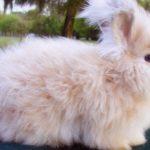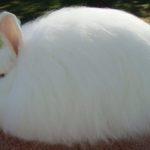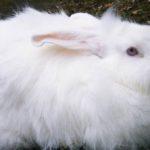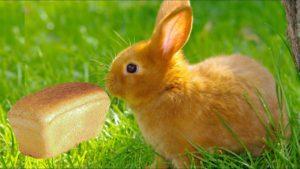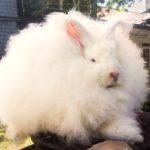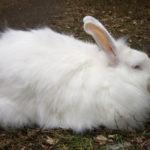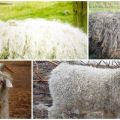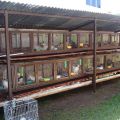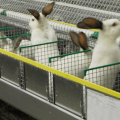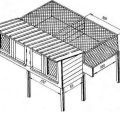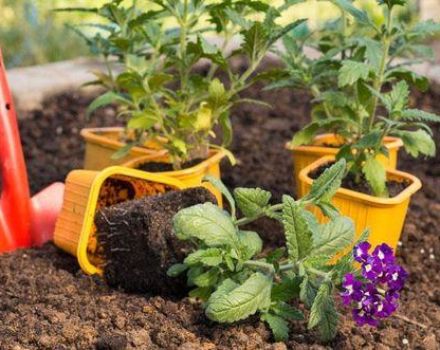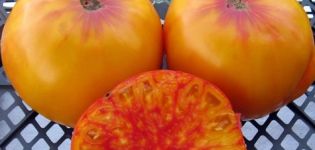Popular breeds of downy rabbits, rules for their maintenance and care
To obtain high-quality textiles, felt, knitwear, along with angora, cashmere and alpaca wool, mankind also uses the wool of downy rabbits. They give thin long fluff, practically have no guard hair and have an attractive appearance, due to which they are bred not only for industrial, but also for decorative purposes.
Features of the direction
Those fluffy rabbits that we are used to did not exist in nature. All breeds now being raised were obtained through long-term multi-stage selection. Animals were selected according to the characteristics of productivity, quality, length and softness of down, early maturity and other important indicators. It is difficult to breed downy rabbits, since they need to be carefully looked after, properly fed, created special living conditions, and monitored the condition of the coat. At the moment, the main rabbit farms for the production of valuable down are located in a number of Western European countries and in China.
In breeding for down, males participate, but the products themselves are collected only from females, since in males the down fibers are thicker and stiffer. Females produce warm, soft and light material.
Popular breeds of downy rabbits
At the moment, the following breeds of downy rabbits are actively bred:
- Angora rabbit. This is one of the oldest breeds obtained from the ancestors brought from Turkey in the 18th century. Initially, such animals served as pets for the nobility, and only after almost two centuries they began to be used in industrial breeding. This breed has a peculiarity: it can be used not only as a downy one, but also as a meat and decorative one. Body weight - up to 4 kilograms, down length - up to 25 centimeters. Animals are famous for their docile and good-natured nature. At the moment, there are several varieties of Angora rabbits:
- English Angora;
- French Angora rabbit;
- German Angora rabbit;
- angora giant;
- dwarf angora rabbit.

- White downy rabbit. This breed was developed in the Soviet Union from the Angora rabbits and the basic local producers - the white giant and the silver rabbit. It was considered a full-fledged breed in 1957. As a result of crossing, large, strong animals with a massive constitution, a rounded head, and straight ears were obtained. Weight reaches 4.5 kilograms, the color of purebred specimens is pure white, and in hybrids it can be white, gray, blue, black. White downy rabbits are red-eyed, the rest of the eyes are dark-colored.
In a year, representatives of the white down breed give from 300 to 500 grams of the finest warm down, and the best samples - from 750 grams to 1 kilogram. To obtain high-quality products, animals need to provide excellent living conditions and good nutrition.
Maintenance and care rules
For downy rabbits, hygiene and balanced feed are of the utmost importance. Since animals have long, thin coats, they should live in clean, often cleaned, ventilated areas, in a dry and warm place, free from drafts and dampness.
Valuable down is taken from these rabbits, so it is best to keep them in cages. So they will not be able to harm each other, and the coat will remain in perfect condition. Young animals are kept 3-4 in one cage, adult downy rabbits - one by one. The floors in cages are mesh or slatted for waste disposal. In cold weather, straw bedding is used, since other types of coating such as shavings or sawdust clog into the wool, spoil the fluff, and cause tangles.
Downy rabbits are fed and watered in the same way as representatives of other breeds. The menu includes compound feed, vegetables, fruits, fresh grass, hay, tree branches and foliage, mineral supplements and vitamins. The presence of clean drinking water is imperative. In order for rabbits to produce excellent quality fluff, their nutrition must be balanced and complete.
How to choose a good rabbit
When choosing a manufacturer, they are guided by pure bred. For this, the purchase is made from a professional breeding the breed strictly according to the standard. The quality is confirmed by documents and a veterinary passport.

Ornamental pets are also undesirable to purchase from hands. It is better to do this at breeders or in specialized rabbit breeding clubs, where the pet will also receive a passport and vaccinations that ensure health and disease-freeness. When choosing, they are guided by the behavior and appearance of the rabbit. He should be active, but not aggressive, clean, with a shiny, glossy coat without mats and parasites, clear eyes. The absence of odors and discharge is important.
A healthy pet is calm, does not refuse food and water. He has no signs of disease and external defects.
Collecting and storing down
The following methods are used to obtain products:
- A haircut.
- Plucking.
- Combing.
The first time, the fluff is obtained from two-month-old rabbits by shearing, then they are sheared twice more - at 4.5 months and at six months. After that, the animals are plucked once a month. In the cold, this is done carefully so that the rabbits do not freeze.
Fluff is not taken from recently hatched or pregnant females, sick animals. The procedure is carried out delicately, without frightening the rabbits. When handled correctly, it does not cause pain or discomfort. On the contrary. Clever fluff removal stimulates dormant follicles and new hairs grow back quickly. Ripe fluff separates effortlessly and without blood.
A haircut allows you to get more fluff at a time. In the removed mass of wool, both coarser guard hairs and a short undercoat remain. This negatively affects the quality of the product.
Combing is laborious, stressful for the crawl itself and the risk of injury to humans. It is not used on farms, but it is vital for decorative pussies. Downy bunnies are cute and useful animals, providing a light and warm material for creating clothes, and also serving as pets.

